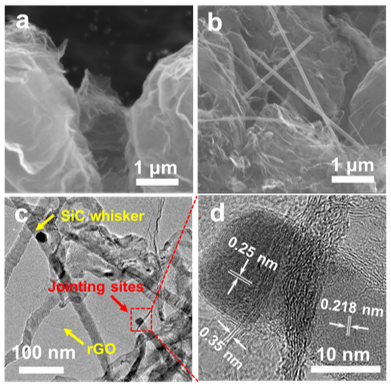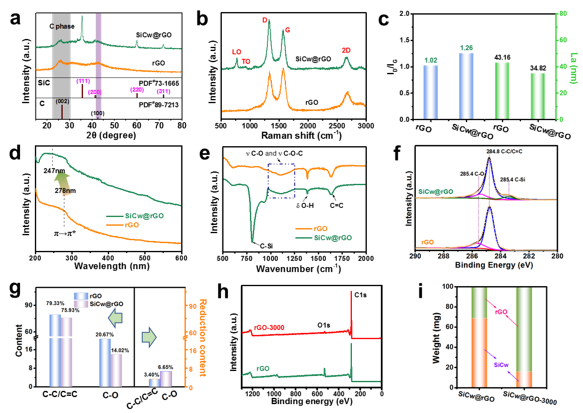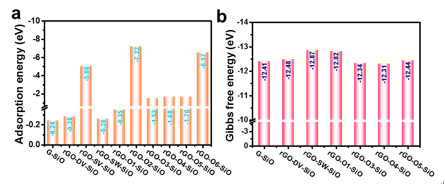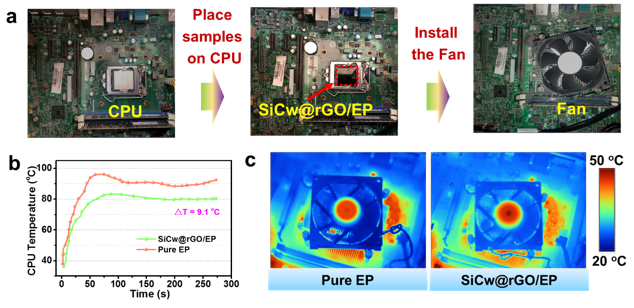碳化硅晶须的形核效应及其在导热和电子绝缘中的潜在应用
随着5G网络时代的到来,大功率、小型化移动电子设备得到迅速发展,如平板电脑、手机等硬件设备。相应地,这导致了电子设备的功耗增加及热量的迅速积累。为了保证电子设备的寿命和可靠性,考虑电子设备的散热问题是非常有必要的。
碳化硅晶须与石墨烯材料的复合被认为是一种可有效提升高分子材料导热性能的潜力材料之一。目前结果表明石墨烯与碳化硅晶须之间形成的C-Si键极大地促进了声子的传输。然而,哪种类型的石墨烯能够形成连接点并提高声子的传输,这一点尚不清楚。也就是说,碳化硅晶须在石墨烯上的可能成核机制需要进一步剖析。
近日,中科院山西煤化所709组在国际期刊Chemical Engineering Journal上发表了题为“SiC whiskers nucleated on rGO and its potential role in thermal conductivity and electronic insulation”的研究型文章(https://doi.org/10.1016/j.cej.2021.130181),论文第一作者陈景鹏,共同第一作者为王哲帆、易宗琳,通讯作者陈成猛研究员与张寿春研究员。作者以还原氧化石墨烯和稻壳灰为原料,通过堆积床法合成了碳化硅晶须/还原氧化石墨烯(SiCw@rGO),其中碳化硅晶须通过碳化硅晶核(C-Si共价键)桥接在还原氧化石墨烯片层上。实验和理论计算结果显示,还原氧化石墨烯的含氧缺陷(C-O基团)为碳化硅成核提供了有利的位点,并提升了碳化硅晶须的产量。还原氧化石墨烯中的某些特定缺陷诱导其周围碳原子形成的孤对电子是形成C-Si共价键的关键因素。由于SiCw@rGO中构建的蓬松结构和缩短的声子传输路径,碳化硅晶须@还原氧化石墨烯/环氧树脂(SiCw@rGO/EP)表现出良好的导热性质。本文的研究为在碳化硅晶须和还原氧化石墨烯片之间建立可控的声子传输通道提供了新的见解。
论文的部分图文如下:

Fig. 1. SEM images of (a) rGO and (b) SiCw@rGO. TEM images of (c) low magnification and (d) high magnification of SiCw@rGO.

Fig. 2. The structural characterizations of rGO and SiCw@rGO. (a) XRD patterns. (b) Raman spectra. (c) ID/IG ratios and Graphite particle size (d) UV-vis absorption spectrum. (e) FT-IR patterns. (f) The C1s XPS spectra of rGO and SiCw@rGO. (g) The content change of C-C and C-O. (h) The XPS spectrum of rGO and rGO-3000. (i) The weight different in SiCw prepared by rGO and rGO-3000.

Fig. 3. Thermodynamically favorable sites of SiO absorbed on the given graphene configuration. The golden yellow, red, and blue balls are C, O, and Si, respectively.

Fig. 4. Electronic localization function (ELF) isosurfaces and a 2D slice of SiO adsorbed on the given configurations: (a) rGO-SV-SiO and (b) rGO-O6-SiO. The PDOS of (c) rGO-SV and (d) rGO-O6 The spin density of the given graphene: (e) rGO-DV, (f) rGO-SV, and (g) rGO-O6 (the isosurface level is 0.03).

Fig. 5. (a) Adsorption energies (Eab) of SiO molecule on the given graphene. (b) Gibbs free energy (G(T)) of SiO molecule diffusion on the surface of the given configuration under 1673 K.

Fig. 6. (a) Thermal conductivity and (b) Electrical conductivity of pure EP and EP composites. (c) Infrared images in the heating and cooling stage. (d-e) Heating and cooling rate of test samples (Rate = (Xt-X0)/t).

Fig. 7. (a) Experimental device and the testing process to analyze dissipation property of the desktop computer system. (b) CPU temperature evolution versus running time. (c) Infrared images of pure EP and SiCw@rGO/EP.
碳化硅晶须的形核效应及其在导热和电子绝缘中的潜在应用
随着5G网络时代的到来,大功率、小型化移动电子设备得到迅速发展,如平板电脑、手机等硬件设备。相应地,这导致了电子设备的功耗增加及热量的迅速积累。为了保证电子设备的寿命和可靠性,考虑电子设备的散热问题是非常有必要的。
碳化硅晶须与石墨烯材料的复合被认为是一种可有效提升高分子材料导热性能的潜力材料之一。目前结果表明石墨烯与碳化硅晶须之间形成的C-Si键极大地促进了声子的传输。然而,哪种类型的石墨烯能够形成连接点并提高声子的传输,这一点尚不清楚。也就是说,碳化硅晶须在石墨烯上的可能成核机制需要进一步剖析。
近日,中科院山西煤化所709组在国际期刊Chemical Engineering Journal上发表了题为“SiC whiskers nucleated on rGO and its potential role in thermal conductivity and electronic insulation”的研究型文章(https://doi.org/10.1016/j.cej.2021.130181),论文第一作者陈景鹏,共同第一作者为王哲帆、易宗琳,通讯作者陈成猛研究员与张寿春研究员。作者以还原氧化石墨烯和稻壳灰为原料,通过堆积床法合成了碳化硅晶须/还原氧化石墨烯(SiCw@rGO),其中碳化硅晶须通过碳化硅晶核(C-Si共价键)桥接在还原氧化石墨烯片层上。实验和理论计算结果显示,还原氧化石墨烯的含氧缺陷(C-O基团)为碳化硅成核提供了有利的位点,并提升了碳化硅晶须的产量。还原氧化石墨烯中的某些特定缺陷诱导其周围碳原子形成的孤对电子是形成C-Si共价键的关键因素。由于SiCw@rGO中构建的蓬松结构和缩短的声子传输路径,碳化硅晶须@还原氧化石墨烯/环氧树脂(SiCw@rGO/EP)表现出良好的导热性质。本文的研究为在碳化硅晶须和还原氧化石墨烯片之间建立可控的声子传输通道提供了新的见解。
论文的部分图文如下:

Fig. 1. SEM images of (a) rGO and (b) SiCw@rGO. TEM images of (c) low magnification and (d) high magnification of SiCw@rGO.

Fig. 2. The structural characterizations of rGO and SiCw@rGO. (a) XRD patterns. (b) Raman spectra. (c) ID/IG ratios and Graphite particle size (d) UV-vis absorption spectrum. (e) FT-IR patterns. (f) The C1s XPS spectra of rGO and SiCw@rGO. (g) The content change of C-C and C-O. (h) The XPS spectrum of rGO and rGO-3000. (i) The weight different in SiCw prepared by rGO and rGO-3000.

Fig. 3. Thermodynamically favorable sites of SiO absorbed on the given graphene configuration. The golden yellow, red, and blue balls are C, O, and Si, respectively.

Fig. 4. Electronic localization function (ELF) isosurfaces and a 2D slice of SiO adsorbed on the given configurations: (a) rGO-SV-SiO and (b) rGO-O6-SiO. The PDOS of (c) rGO-SV and (d) rGO-O6 The spin density of the given graphene: (e) rGO-DV, (f) rGO-SV, and (g) rGO-O6 (the isosurface level is 0.03).

Fig. 5. (a) Adsorption energies (Eab) of SiO molecule on the given graphene. (b) Gibbs free energy (G(T)) of SiO molecule diffusion on the surface of the given configuration under 1673 K.

Fig. 6. (a) Thermal conductivity and (b) Electrical conductivity of pure EP and EP composites. (c) Infrared images in the heating and cooling stage. (d-e) Heating and cooling rate of test samples (Rate = (Xt-X0)/t).

Fig. 7. (a) Experimental device and the testing process to analyze dissipation property of the desktop computer system. (b) CPU temperature evolution versus running time. (c) Infrared images of pure EP and SiCw@rGO/EP.
